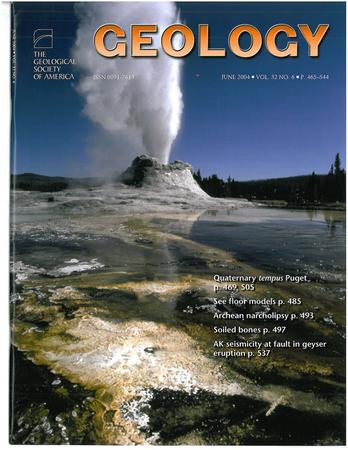Exceptionally preserved ovaries in an ancient horseshoe crab
IF 4.6
1区 地球科学
Q1 GEOLOGY
引用次数: 0
Abstract
Horseshoe crabs are an ancient lineage of aquatic chelicerate arthropods traditionally considered to be “living fossils” exhibiting limited morphological change throughout their evolution. This paradigm is challenged by the divergent morphologies of Paleozoic and Mesozoic xiphosurans in nonmarine environments, which show greater variation of prosomal carapace shape. Marine horseshoe crabs appear to exhibit a more conservative evolutionary history punctuated by marked increases in body size during the Carboniferous and Jurassic. However, interpretation of horseshoe crab evolutionary trends is complicated by uncertainty over whether the smaller Paleozoic species represent adults or juveniles. Here, we describe a diminutive 445-million-year-old horseshoe crab, Lunataspis gundersoni sp. nov., preserving details of ovarian structures in the prosoma. Unique among Xiphosura, the new species possesses an unusually prolongated prosoma, indicating early morphological variation within the group. However, the female reproductive system appears identical to that of extant Tachypleinae. Critically, the presence of eggs demonstrates that the specimens are adults and that horseshoe crabs were significantly smaller in size during the Paleozoic. Lunataspis gundersoni displays a mixture of divergent external and conserved internal anatomy that reveals mosaic evolutionary patterns and illustrates early morphological variation among marine Xiphosura.古马蹄蟹保存完好的卵巢
马蹄蟹是一种古老的水生螯合节肢动物,传统上被认为是“活化石”,在整个进化过程中表现出有限的形态变化。这一模式受到了古生代和中生代剑龙在非海洋环境中形态差异的挑战,它们显示出更大的前体甲壳形状变化。在石炭纪和侏罗纪,海洋马蹄蟹似乎表现出一种更为保守的进化历史,其体型的显著增加贯穿其间。然而,对马蹄蟹进化趋势的解释是复杂的,因为不确定较小的古生代物种是代表成年还是幼年。在这里,我们描述了一种4.45亿年前的小型马蹄蟹,Lunataspis gundersoni sp. nov.,它保留了原体中卵巢结构的细节。独特的剑龙,新物种具有一个异常延长的原体,表明早期形态变异的群体。然而,雌性的生殖系统似乎与现存的速叶虫相同。重要的是,卵的存在表明这些标本是成年的,而且在古生代马蹄蟹的体型要小得多。Lunataspis gundersoni显示了不同的外部和保守的内部解剖结构的混合物,揭示了马赛克进化模式,并说明了海洋剑龙的早期形态变异。
本文章由计算机程序翻译,如有差异,请以英文原文为准。
求助全文
约1分钟内获得全文
求助全文
来源期刊

Geology
地学-地质学
CiteScore
10.00
自引率
3.40%
发文量
228
审稿时长
6.2 months
期刊介绍:
Published since 1973, Geology features rapid publication of about 23 refereed short (four-page) papers each month. Articles cover all earth-science disciplines and include new investigations and provocative topics. Professional geologists and university-level students in the earth sciences use this widely read journal to keep up with scientific research trends. The online forum section facilitates author-reader dialog. Includes color and occasional large-format illustrations on oversized loose inserts.
 求助内容:
求助内容: 应助结果提醒方式:
应助结果提醒方式:


